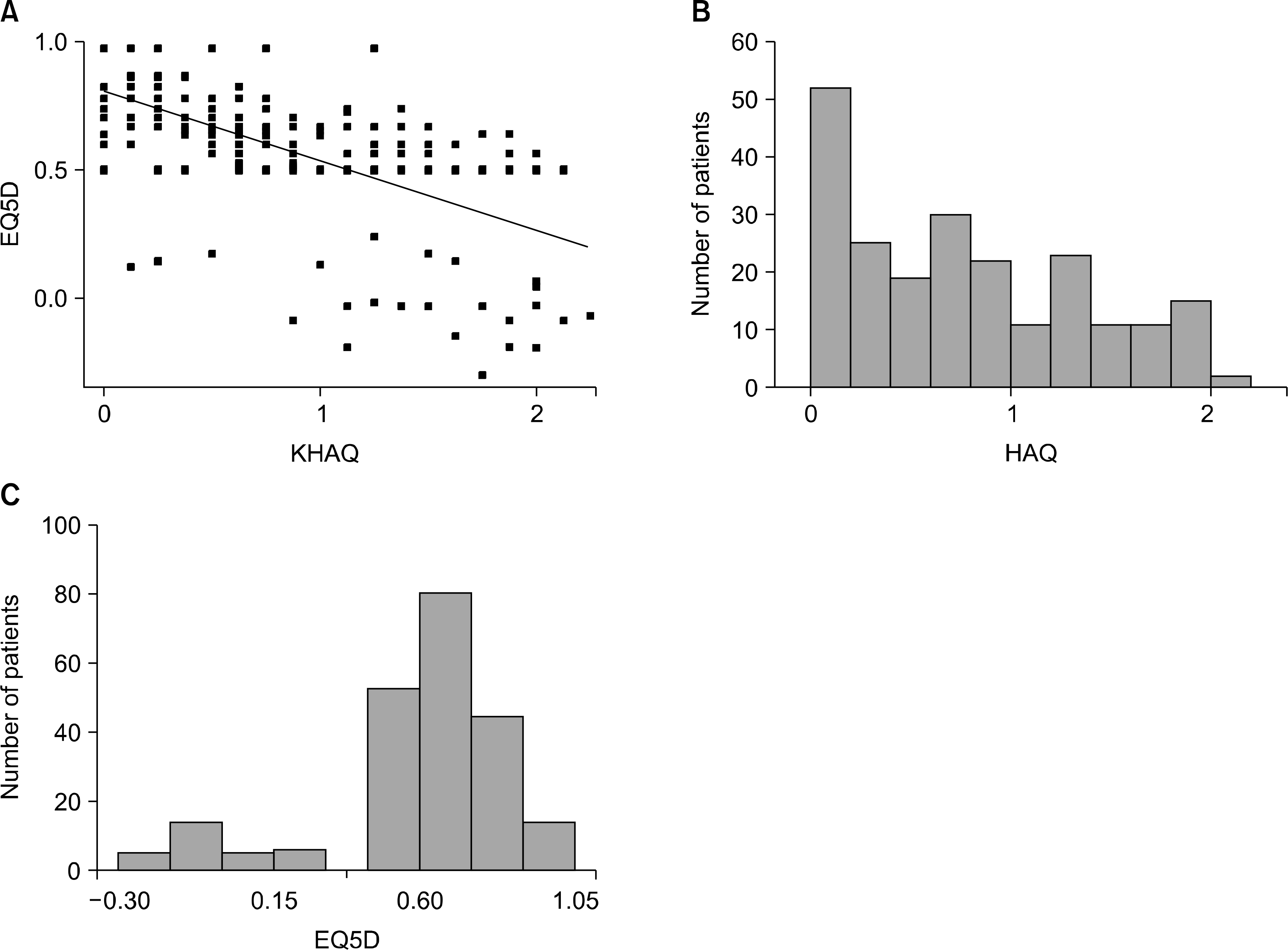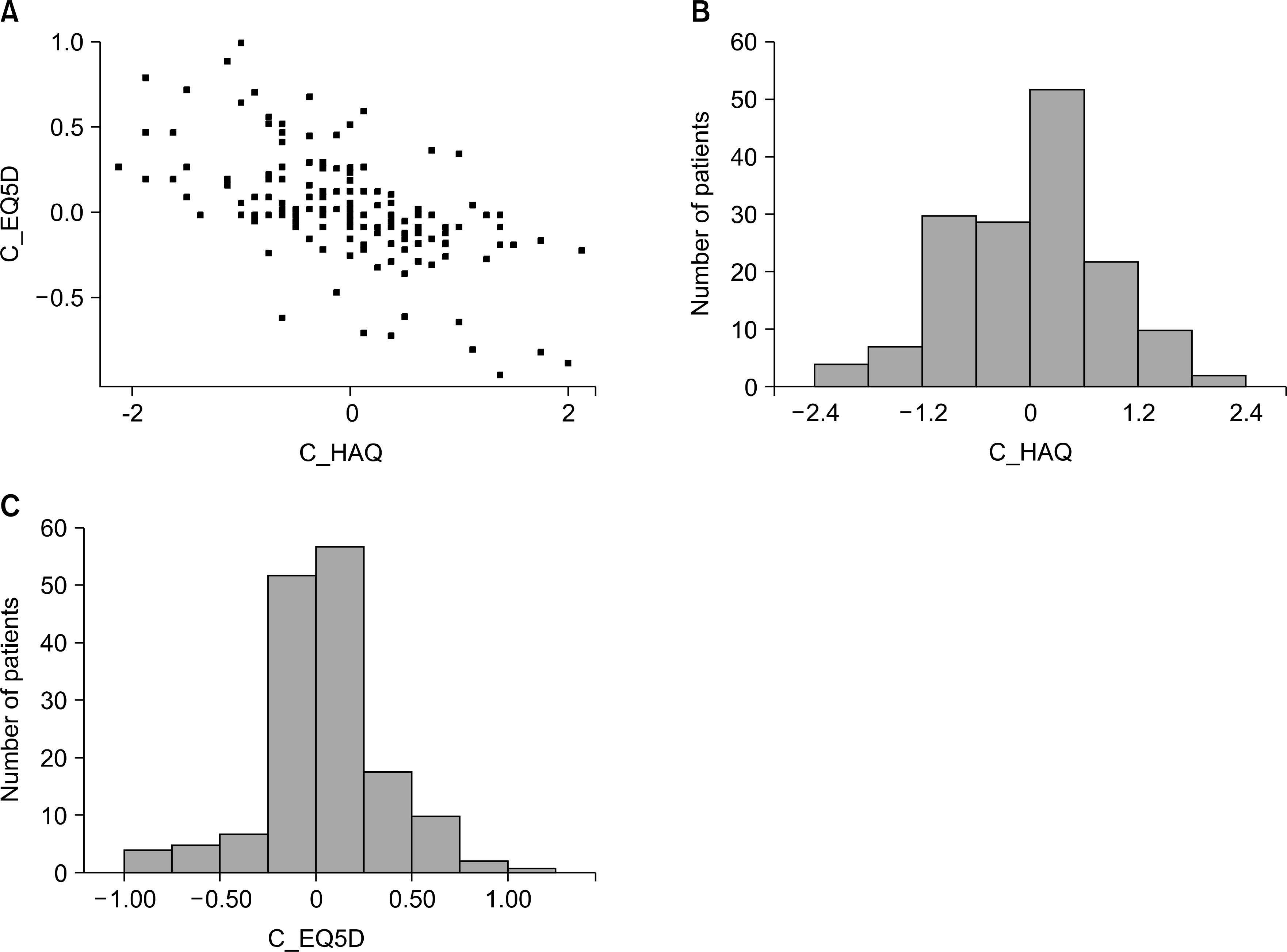Abstract
Objective
Assessment of health-related quality of life in patients with rheumatoid arthritis (RA) has become important in health research. Health economists have used linear regression equations to mathematically transform changes in HAQ scores into EQ5D data, which can be used to calculate quality adjusted life years (QALYs). We aimed to examine whether a given approach is justified.
Methods
A total of 223 patients with RA were recruited from the Hospital for Rheumatic Diseases at Hanyang University. They completed the HAQ and EQ5D and a correlation analysis was performed between the two instruments. We compared HAQ and EQ5D score changes for patients who completed the EQ5D and HAQ at first and second visits (n=159). Predicted EQ5D was estimated from the HAQ using the calculating method of Bansnack et al. The mean difference between the predicted EQ5D from the HAQ and observed health utility score at the first visit and change during the study were tested by the paired t-test.
Results
In the cross-sectional study, EQ5D scores were moderately inversely correlated with HAQ (r=–0.716, p < 0.001). However, the predicted EQ5D from the HAQ was significantly different from the observed EQ5D (p=0.001; 95% confidence interval [CI] 0.020~0.079). The change in EQ5D was also inversely correlated with the change in the HAQ (r=–0.615, p < 0.001), and change in the predicted EQ5D scores corresponded well with changes in observed health utility scores (p=0.155; 95% CI (–0.0873~0.0140).
Go to : 
REFERENCES
1). Sherrer YS., Bloch DA., Mitchell DM., Roth SH., Wolfe F., Fries JF. Disability in rheumatoid arthritis: comparison of prognostic factors across three populations. J Rheumatol. 1987. 14:705–9.
2). Kaplan RM., Anderson JP. A general health policy model: update and applications. Health Serv Res. 1988. 23:203–35.
3). Hurst NP., Kind P., Ruta D., Hunter M., Stubbings A. Measuring health-related quality of life in rheumatoid arthritis: validity, responsiveness and reliability of EuroQol (EQ-5D). Br J Rheumatol. 1997. 36:551–9.

4). Kim MH., Cho YS., Uhm WS., Kim S., Bae SC. Cross-cultural adaptation and validation of the Korean version of the EQ-5D in patients with rheumatic diseases. Quality of Life Research. 2005. 14:1401–6.

5). Fries JF., Spitz P., Kraines RG., Holman HR. Measurement of patient outcome in arthritis. Arthritis Rheum. 1980. 23:137–45.

6). Torrance GW., Feeny DH., Furlong WJ., Barr RD., Zhang Y., Wang Q. Multiattribute utility function for a comprehensive health status classification system: Health Utilities Index Mark2. Med Care. 1996. 34:702–22.
7). Brenna A., Bansback N., Reynolds A., Conway P. Modeling the cost-effectiveness of etanercept in adults with rheumatoid arthritis in the UK. Rheumatology (Oxford). 2004. 43:62–72.
8). Tanno M., Nakamura I., Ito K., Tanaka H., Ohta H., Kobayashi M, et al. Modelling and cost-effectiveness analysis of etanercept in adults with rheumatoid arthritis in Japan: a preliminary analysis. Mod Rheumatol. 2006. 16:77–84.
9). Linde L., SoSrensen J., OSstergaard M., HoSrslev-Pedersen K., Lund Hetland M. Health-related quality of life: validity, reliability, and responsiveness of SF-36, EQ-15D, EQ-5D, RAQoL, and HAQ in patients with rheumatoid arthritis. J Rheumatol. 2008. 35:1528–37.
10). Kim CG., Oh KT., Choe JU., Bae SC. Health-related quality of life in korean patients with rheumatoid arthritis. J Korean Rheum Assoc. 2002. 9:S60–72.
11). Bae SC., Cook EF., Kim SY. Psychometric evaluation of a Korean Health Assessment Questionnaire for clinical research. J Rheumatol. 1998. 25:1975–9.
12). Bansback N., Marra C., Tsuchiya A., Anis A. Using the health assessment questionnaire to estimate preference-based single indices in patients with rheumatoid arthritis. Arthritis Rheum. 2007. 57:963–71.

13). Ware JE., Snow KK., Kosinski M., Gandek B. SF-36 Health Survey Manual and Interpretation Guide. Boston, MA, New England Medical Center, The Health Institute. 1993.
14). Bergner M., Bobbitt RA., Carter WB., Gilson BS. The sickness impact Profile: development and final revision of a health status measure. Med Care. 1981. 19:787–805.

15). Torrance GW., Thomas WH., Sackett DL. A utility maximization model for evaluation of health care programs. Health Serv Res. 1972. 7:118–33.
16). Meenan RF., Gertman PM., Mason JH. Measuring health status in arthritis. The arthritis impact measurement scales. Arthritis Rheum. 1980. 23:146–52.
17). Fries JF., Spitz PW., Young DY. The dimensions of health outcomes: the Health Assessment Questionnaire, disability and pain scales. J Rheumatol. 1982. 9:789–93.
Go to : 
 | Fig. 1.Cross-sectional observational study. (A) EQ5D scores were moderately inversely correlated with HAQ (r=.0.716, p0.001), (B) Distribution of HAQ, (C) Distribution of EQ5D. |
 | Fig. 2.Longitudinal observational study. (A) Change in EQ5D was moderately inversely correlated with HAQ change (r=.0.615, p0.001), (B) Distribution of changes in HAQ, (C) Distribution of changes in EQ5D. |
Table 1.
Sociodemographic and clinical features in patients with rheumatoid arthritis




 PDF
PDF ePub
ePub Citation
Citation Print
Print


 XML Download
XML Download